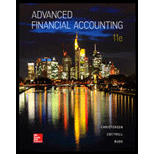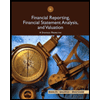
a
Concept introduction: Consolidation in a subsequent year is fundamentally the same as used in the first year. Adjusted
Reconciliation between the balances in P’s investment in L company stock account on December 31 20X7.
a
Answer to Problem 7.33P
Reconciliation between P’s investment in L on December 31 20X7 shows balance of $240,000 in investment account.
Explanation of Solution
Reconciliation of book value and balance in investments.
| Net book value reported by L company | ||
| Common stock | $100,000 | |
| Retained Earnings January 1 20X7 | $140,000 | |
| Net income for 20X7 | 45,000 | |
| Dividends paid in 20X7 | (35,000) | |
| Retained earnings Balance December 31 20X7 | 150,000 | |
| $250,000 | ||
| Proportion of stock held by P ($250,000 X 0.80) | $200,000 | |
| Add: | 40,000 | |
| Balance in investment account | $240,000 |
b
Concept introduction: Consolidation in a subsequent year is fundamentally the same as used in the first year. Adjusted trial balance data of the individual companies are used for consolidation in the second year. In addition to that, the balances of consolidated retained earnings beginning and end are compared to check if it is equal in each period.
Consolidation entries needed and prepare complete consolidation work sheet.
b
Explanation of Solution
Consolidation elimination entries:
| Debit $ | Credit $ | |
| 1. Eliminate income from subsidiary | ||
| Income from subsidiary | 38,000 | |
| Dividends declared | 28,000 | |
| Investment in L common stock | 10,000 | |
| (Income from subsidiary eliminated by reversal) | ||
| 2. Assign income to non-controlled interest | ||
| Income from non-controlled interest | 9,000 | |
| Dividends | 7,000 | |
| Non-controlling interest | 2,000 | |
| (Income assigned to non-controlling interest) | ||
| 3. Eliminate beginning investment balance | ||
| Common stock L company | 100,000 | |
| Retained earnings January 1 | 140,000 | |
| Differential | 50,000 | |
| Investment in L stock | 232,000 | |
| Non-controlling interest | 58,000 | |
| (Beginning investment eliminated by reversal) | ||
| 4. Assigning differential to goodwill | ||
| Goodwill | 25,000 | |
| Retained earnings January 1 | 20,000 | |
| Non-controlling interest | 5,000 | |
| Differential | 50,000 | |
| (Differential assigned to goodwill) | ||
| 5. Elimination unrealized profit on land | ||
| Retained earnings January 1 | 8,000 | |
| Non-controlling interest | 2,000 | |
| Land | 10,000 | |
| (Being unrealized profit on land is eliminated by reversal) | ||
| 6. Elimination of unrealized profit on equipment | ||
| Buildings and equipment | 5,000 | |
| Retained earnings January 1 | 18,000 | |
| | 2,000 | |
| | 21,000 | |
| (Elimination of unrealized profit on equipment) | ||
| 7. Elimination of inter-corporate receivable / payable | ||
| Accounts payable | 4,000 | |
| | 4,000 | |
| (Intercompany receivable and payable eliminated by setoff) |
P & L Company
Consolidation Worksheet
December 31 20X7
| Eliminations | |||||
| Item | P $ | L $ | Debit$ | Credit$ | Consolidated $ |
| Sales | 250,000 | 150,000 | 400,000 | ||
| Income from subsidiary | 38,000 | 38,000 | |||
| 288,000 | 150,000 | 400,000 | |||
| Cost of goods sold | 160,000 | 80,000 | 240,000 | ||
| Depreciation & amortization | 25,000 | 15,000 | 2,000 | 38,000 | |
| Other expenses | 20,000 | 10,000 | 30,000 | ||
| (205,000) | (105,000) | (308,000) | |||
| Consolidated net income to non-controlled interest | 92,000 | ||||
| 9,000 | (9,000) | ||||
| Income carry forward | 81,000 | 45,000 | 45,000 | 2,000 | 83,000 |
| Retained earnings Jan 1 | 420,000 | 140,000 | 140,000 | ||
| 20,000 | |||||
| 8,000 | |||||
| 18,000 | 374,000 | ||||
| Income from above | 81,000 | 45,000 | 45,000 | 2,000 | 83,000 |
| 501,000 | 185,000 | 457,000 | |||
| Dividends declared | (60,000) | (35,000) | 28,000 | ||
| 7,000 | (60,000) | ||||
| Retained earnings Dec 31 | 441,000 | 150,000 | 231,000 | 37,000 | 397,000 |
| Cash and receivable | 151,000 | 55,000 | 4,000 | 202,000 | |
| Inventory | 240,000 | 100,000 | 340,000 | ||
| Land | 100,000 | 80,000 | 10,000 | 170,000 | |
| Buildings and equipment | 500,000 | 150,000 | 5,000 | 655,000 | |
| Less Depreciation | (230,000) | (60,000) | (21,000) | (311,000) | |
| Investment in L stock | 240,000 | 8,000 | |||
| 232,000 | |||||
| Differential | 50,000 | 50,000 | |||
| Goodwill | 25,000 | 25,000 | |||
| Total assets | 1,001,000 | 325,000 | 1,081,000 | ||
| Accounts payable | 60,000 | 25,000 | 4,000 | 81,000 | |
| Bonds payable | 200,000 | 50,000 | 250,000 | ||
| Common stock | 300,000 | 100,000 | 100,000 | 300,000 | |
| Retained earnings | 441,000 | 150,000 | 231,000 | 37,000 | 397,000 |
| 5,000 | 2,000 | ||||
| 2,000 | 58,000 | 53,000 | |||
| Liabilities and equity | 1,001,000 | 325,000 | 442,000 | 497,000 | 1,081,000 |
Working notes:
Consolidated net income for December 31 20X8 is $83,000 and Net Assets are $1,081,000
- Income from subsidiary is eliminated by treating it as dividends
- Income from non-controlling interest is recognized
- Investment balances has been eliminated
- Assignment if differential to goodwill
- Unrealized profit on sale of land is eliminated
- Unrealized profit on sale of equipment is eliminated
- Intercompany accounts receivable and payable is eliminated by setoff
| Sales | $150,000 |
| Less: Cost of sales | ($80,000) |
| Depreciation amortization | ($15,000) |
| Other expenses | ($10,000) |
| Income on intercompany | $45,000 |
| Eliminate beginning investment balance | ||
| Working note: | ||
| P company’s holding at 80 percent | $160,000 | |
| Non-controlling interest | 40,000 | |
| $200,000 | ||
| Less: L’s common stock outstanding at acquisition | $100,000 | |
| L’s retained earnings at acquisition | 50,000 | |
| $150,000 | ||
| Differential | $50,000 | |
| Investment in L company stock | ||
| Working note: | ||
| Balance in investment account after reconciliation | $240,000 | |
| Less: investment in L stock | 8,000 | |
| Current investment in L stock | $232,000 | |
| Non-controlling interest | ||
| Working notes: | ||
| Common stock L | $100,000 | |
| Retained earnings of L on January 1 | $140,000 | |
| Retained earnings of L at acquisition | 50,000 | |
| $290,000 | ||
| $58,000 |
| Accumulated depreciation adjustments | |
| Required balance | $35,000 |
| Balance recorded | (14,000) |
| Increase | 21,000 |
Want to see more full solutions like this?
Chapter 7 Solutions
Advanced Financial Accounting
- Tartt Enterprises has inventory days of 48, accounts receivable days of 32, and accounts payable days of 27. What is its cash conversion cycle? A.) 40 days B.) 53 days C.) 65 days D.) 80 daysarrow_forwardPlease provide the accurate answer to this general accounting problem using appropriate methods.arrow_forwardTutor please provide answer for this MCQarrow_forward
- Help with accounting questionarrow_forwardThe lotion manufacturing's quick ratio is ?arrow_forwardHalle Manufacturing has an overhead application rate of 125% and allocates overhead based on direct materials. During the current period, direct labor is $78,000, and direct materials used are $112,000. Determine the amount of overhead Halle Manufacturing should record in the current period. a. $78,000 b. $97,500 c. $112,000 d. $140,000 e. $190,000arrow_forward
- I need guidance with this general accounting problem using the right accounting principles.arrow_forwardWhat is its cash conversion cycle?arrow_forwardBruce Company sold 1,500 units of its product during the current month. The selling price is $45 and the variable cost is $28 per unit. The company's fixed expense totals $11,700 per month. The company's net operating income is: a. $13,800 b. $25,500 c. $17,100 d. $42,000arrow_forward
- August's beginning and ending inventories were 24,600 and 16,200 units, respectively.arrow_forwardWhich accounting concept supports recording bad debt expense before accounts are actually uncollectible? a) Full disclosure principle b) Matching principle c) Going concern concept d) Materiality concept. Helparrow_forwardWhat is the unit product cost for job 882?arrow_forward
 Financial Reporting, Financial Statement Analysis...FinanceISBN:9781285190907Author:James M. Wahlen, Stephen P. Baginski, Mark BradshawPublisher:Cengage Learning
Financial Reporting, Financial Statement Analysis...FinanceISBN:9781285190907Author:James M. Wahlen, Stephen P. Baginski, Mark BradshawPublisher:Cengage Learning Intermediate Accounting: Reporting And AnalysisAccountingISBN:9781337788281Author:James M. Wahlen, Jefferson P. Jones, Donald PagachPublisher:Cengage Learning
Intermediate Accounting: Reporting And AnalysisAccountingISBN:9781337788281Author:James M. Wahlen, Jefferson P. Jones, Donald PagachPublisher:Cengage Learning


